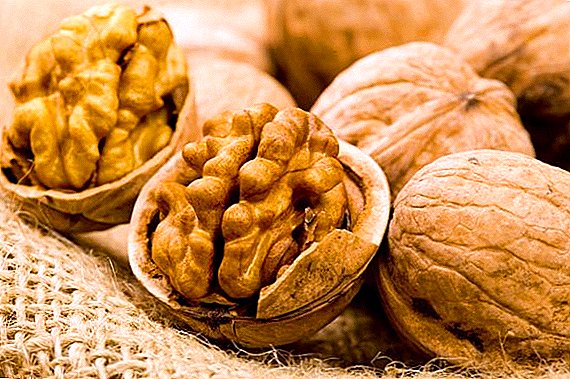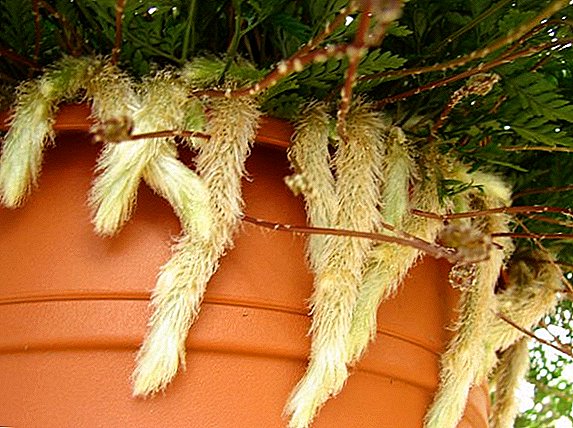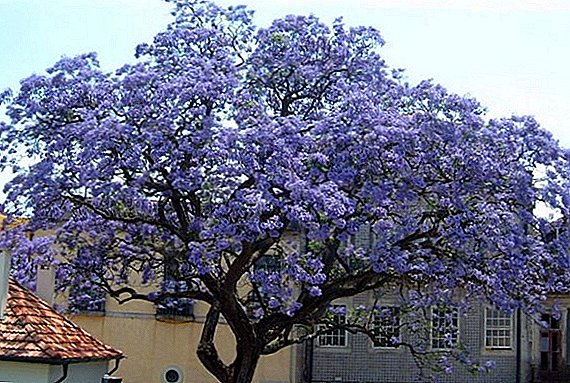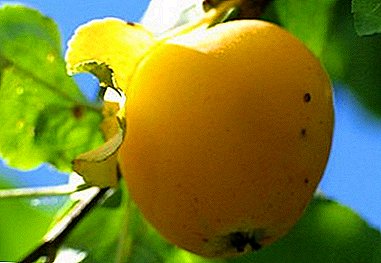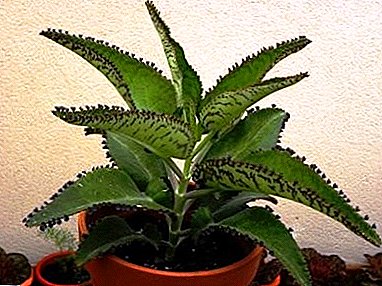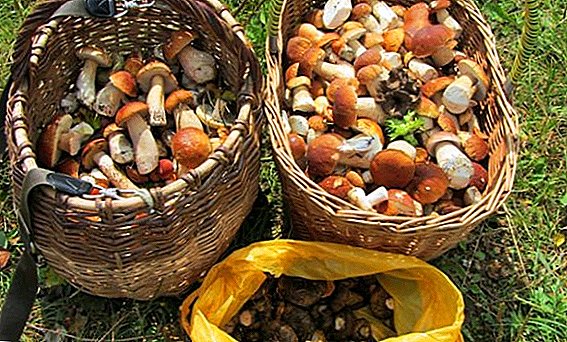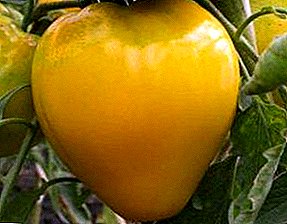 Often we do not even suspect about the beneficial properties and vitamin-mineral riches of the grass growing right outside the house, in a country plot or in the garden, calling it a weed.
Often we do not even suspect about the beneficial properties and vitamin-mineral riches of the grass growing right outside the house, in a country plot or in the garden, calling it a weed.
At the same time, everyone probably saw the shepherd's bag - grass, which has unique healing properties and is able to provide effective assistance in the treatment and prevention of gynecological and other diseases.
Consider its features in the article.
Botanical description: looks like
A shepherd's purse, or a handbag, that in Latin is called Capsella bursa pastoris - this is the correct name of this herbaceous plant, widespread in temperate and tropical latitudes. It is unpretentious, and it can often be seen growing along the road, in vegetable gardens and fields.
The plant has a single straight branching stalk, which can reach 60 cm in height, it has a thin spindle-shaped root. It is annual and in botany belongs to the cruciferous family. Its fruits are similar in appearance to the shepherd's bag, due to which the grass received such a name.  The inflorescences are located on the crown of the stem and become larger during the fruiting period. Fruits are like hearts - this is a constant indicator of what plant in front of you.
The inflorescences are located on the crown of the stem and become larger during the fruiting period. Fruits are like hearts - this is a constant indicator of what plant in front of you.
Small white flowers have four petals each. Grass seeds are oval. The plant is very fertile, since one individual can produce from 40 to 70 thousand seeds, which can grow at any time of the year, as there is a winter and spring form.
Chemical composition
The richness of the composition of the herb is the key to its successful application in traditional medicine, because the shepherd's bag contains:
- bursa, tartaric, citric, malic, ascorbic acid;
- choline;
- vitamin K;
- flavonoids;
- tannins;
- carotenoids;
- carbohydrates;
- thiamine;
- saponins.
Thiamine, or vitamin B1, is not synthesized by the human body, it is necessary for the normal functioning of the nervous system, it is found in black grapes, kivano, spirulina, radishes, peanuts, eggs, bananas, mountain ash red, longane, endive, garlic, rocambole, cashew, asparagus, cranberries, raisins, kumquat.

Medicinal properties
The shepherd's purse is an effective means for solving many medical problems: treating diseases, eliminating symptoms. Useful properties of this plant are well studied both traditional and traditional medicine, and successfully used in practice. First of all, it is:
- Hemostatic property. Most often, this herb effect is used in gynecology, for uterine bleeding and atony of the uterus, but it is also used to eliminate bleeding in the kidneys, lungs and intestines. Shepherd's purse is one of the main components in the pharmaceutical herbal hemostatic collection.
- Anti-inflammatory. Making external lotions using a shepherd's bag, you can achieve the elimination of the inflammatory process, the removal of puffiness, stop the bleeding of superficial wounds on the skin and mucous surfaces.
- Diuretic - in the treatment of the urinary system and kidneys, the grass reduces inflammation, for example, in pyelonephritis, cystitis, urolithiasis.
- Cleans the blood, removing toxins and accumulations of harmful substances from the blood. The action of drugs created on the basis of a medicinal plant is aimed at improving the state of the body of people taking drugs to fight cancer.
- Astringent The properties of herbs are used to treat painful conditions of the stomach and intestines. It has a beneficial effect on peristalsis, can accelerate the healing process of ulcerative foci, erosions and inflammations of the mucous membrane.
- Dilates blood vessels, which has a beneficial effect on the state and work of the cardiovascular system. Drinking a cup of tea with a shepherd's handbag daily, you take care of strengthening the heart muscle and good vascular permeability. Accordingly, blood pressure will also be close to normal age indicators.
- Shepherd's purse has a soothing effect., helps to normalize sleep and minimize the effects on the body of stress and depression.
Hemp, willow, goat willow, dodder, sow thistle, basil, quince, knotweed, purple stonecrop, cherry leaves, kupena, willow grasses, aloe, hemp nettle, hellebore, mandarins, berania, mountain arboreal possesses hemostatic properties.
Shepherd's bag
Shepherd's bag can be used in different ways, using one or another part of a herbaceous plant. The most widely and most effectively use it in medicine, but inventive chefs will surprise you with unusual delicacies from this inconspicuous herb.
In medicine
In therapeutic practice, the plant is used as a means to normalize blood pressure, helps eliminate inflammation, has anti-fever effect. Taking broths and teas from the shepherd's bag, you can achieve a diuretic effect.
Due to the fact that the composition of the medicinal herb includes a large amount of potassium, people at the age are recommended to use the leaves and flowers of the plant to improve the functioning of the heart.
For the preparation of medicinal decoctions and teas take only the dried ground portion of the grass. 
In cooking
Since ancient times, the culinary traditions of many nations have included the use of a shepherd's bag as a source of vitamins, especially during the period of lack of greenery in spring.
In the modern world, this herb is actively used in India, where it can serve as an independent side dish; mashed potatoes are also made from it and used as a filling for dough products.
The shepherd's purse may also be seasoning, but the seeds of the mature plant provide a richer flavor. As a spice, it can add a bitter taste and aroma, being therefore an analogue of pepper and mustard.
Learn more about the properties of mustard, pepper, cloves, cinnamon, bay leaf, saffron, savory, turmeric, cilantro, chervil, marjoram, peppermint, anise, parsley, dill, oregano, rosemary, monard, thyme.
In gynecology
The most popular and widespread use of the shepherd's bag in gynecology. It can effectively affect the irregular menstrual cycle, menstruation with complications, heavy and long-term bleeding, as well as bleeding that occur in the postpartum period. In addition to these indications for the use of medicinal herbs, there are such ones: vomiting during pregnancy, atony and uterine fibroma, and oncological diseases. 
Did you know? Shepherd's purse can be an excellent feed for rabbits, to act as a mustard substitute in mustard plaster. Also, the oil obtained from this herb can be used for technical needs.
Harm and contraindications
The chemical composition of the grass does not contain substances that could adversely affect the human body that uses the shepherd's bag, however, given the properties of the grass, it should not be taken by people who have diseases or problems with blood clotting:
- hypercoagulation;
- thrombocytosis;
- hemorrhoids;
- varicose veins.
The shepherd's bag of drugs: how to take
Shepherd's purse can act as the main ingredient, in the kitchens of some nations, and as an additional component. With its use, soups are prepared, it acts as a seasoning for fish and meat dishes, but, of course, the most popular way to use this medicinal herb is to prepare drinks in which the shepherd's bag is the main ingredient.
Tea
For the prevention of most of the diseases listed above, for example, to improve blood circulation and dilation of blood vessels, it is recommended to use a cup of tea (maximum two) per day.
To prepare you need to take 1 tsp. dry grass and pour it a glass of boiling water.
You can also make a stronger tea drink: 2 tsp. dry weed pour 1 tbsp. boiling water and let it brew for 10 minutes, then strain. Drink a cup 2 times a day.
Infusion
To prepare the infusion is better to use a thermos. So, for starters, you want to take 1 tbsp. l grass in a glass of boiling water and pour it into a thermos. Under conditions of maintaining a high temperature, the drink will be sufficient to brew for an hour. Then the content is better to pass through a gauze or sieve. Take the infusion is necessary 4 times a day and 1 tbsp. l
The shepherd's bag infusion is very useful for bleeding that occurs in the stomach, kidneys, lungs, uterus, and even in the nose. This drink will be useful in the postpartum period, as well as for menorrhagia. It acts as a wound-healing agent, so it is often used for injuries.
Tincture
For the preparation of alcohol tinctures need 70% alcohol. You will need to take 10 g of dry grass per 100 ml of alcohol: pour the grass with alcohol and place it in a glass dish. Let it stand for 10-14 days. Take this alcohol tincture should be in the following doses: 20-30 drops three times a day - it is better to dilute the tincture in a small amount of water, it will be enough 1 tsp.
Tincture is often used as a means to lower blood pressure.
In hypertension, you should take a closer look at Kalina, onions, marigolds, foxglove, beets, clover, cornflowers, lohu silver, white silverweed, persimmon, Laconosa.
The juice
The shepherd's bag juice is very effective in treating and preventing all the diseases listed above. In the period of appearance of fresh greenery, from spring to autumn, the most effective use of medicinal herbs.
For the preparation of juice used fresh grass. The resulting product must be diluted in a 1: 1 ratio with boiled water. Apply the juice inside 40 drops 3 times a day, and you can treat them superficial wounds, abrasions, use to rinse the mouth. 
Did you know? In China, the shepherd's purse plant is grown as a vegetable and is actively used in the preparation of both everyday and festive dishes.
Growing a shepherd's bag
Shepherd's purse is a fairly common plant in our latitudes, and it can be seen in almost every park, in the courtyard of a house, outside the city - along roads, in fields and gardens. From all this we can conclude that this grass is quite unpretentious and easily propagates, expanding its range, so you will not find it difficult to find it.
If you need to use a shepherd's bag in significant quantities - for use as a remedy or for eating, then we recommend that you familiarize yourself with some tips on its breeding.
Sowing and reproduction
For planting a shepherd's purse, it is best to choose early spring, since the vegetative period is long enough. Autumn sowing is also possible, but the first shoots will appear only with the onset of spring heat.  For planting should choose a sunny place. Grass seeds must be mixed with sand in a proportional ratio of 1: 5 and sow evenly at a distance of at least 20 cm from each other. Crops lightly sprinkled with earth, the first shoots may appear after a week.
For planting should choose a sunny place. Grass seeds must be mixed with sand in a proportional ratio of 1: 5 and sow evenly at a distance of at least 20 cm from each other. Crops lightly sprinkled with earth, the first shoots may appear after a week.
Important! For planting it is best to use seeds collected in the summer.
Soil and fertilizer
The soil before planting should be moist and nutritious: ideally it will be possible to choose a period when snow has just melted and there is still enough water in the ground. Experienced gardeners argue that for planting a shepherd's bag should prepare the soil in the same way as before sowing cabbage or leaf mustard.
It is necessary to feed a grassy plant once per season, using mineral fertilizers for flowering plants.
Watering and moisture
Water the plant should only be in a period of severe drought: if the soil is wet enough, then additional watering is not required. There is no need to weed the planting, it is only important to ensure that the weeds do not grow in such a way that they prevent the ingress of sunlight and interfere with the growth of grass.
Find out how other crucifers are grown - cabbage, radish, canola, mustard.
Diseases and pests
A shepherd's purse may suffer from such pests as:
- powdery mildew. To get rid of this disease can, using folk remedies: mullein, infusion of ash, soda ash. There are also modern chemicals that can eliminate it;
- cruciferous flea. In order to get rid of harmful insects, it is recommended to powder the planting with ashes.
Harvesting and storage of raw materials
Since the shepherd's handbag can be planted twice a year, respectively, the crop can also be harvested twice a year. If the planting took place in spring, the crop will appear at the very beginning of autumn, and if the planting of seeds occurred in the autumn period, it is possible to harvest the plant after wintering, as soon as it blooms. 
Important! You can not engage in harvesting after rain or dew - the stems and leaves of the plant should not be wet.Removing the bush from the ground, it is necessary to remove the root system. Next, the resulting raw materials begin to dry, placing in a dry and dark place where there is good air access. To improve the quality of drying, it is better to spread the grass in a thin layer on a sheet of paper.
Pre-worth a visual inspection of raw materials, in order to prevent plants damaged by pests or diseases to further drying. Recommended temperature is above 45 ° C.
The use of natural resources is a great opportunity to improve health and prevent dangerous diseases in a simple and useful way.
A shepherd's bag is not just weed grass near the house or along the road, it can save a person’s life by stopping the bleeding, or improve his health, for example, by increasing the permeability of blood vessels and prevent a stroke.


